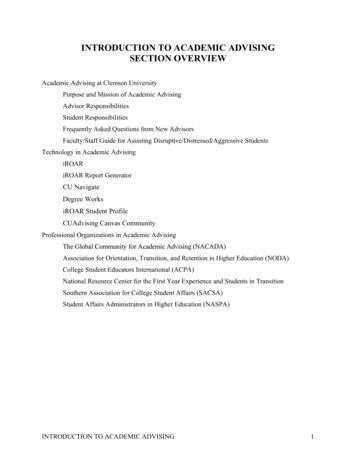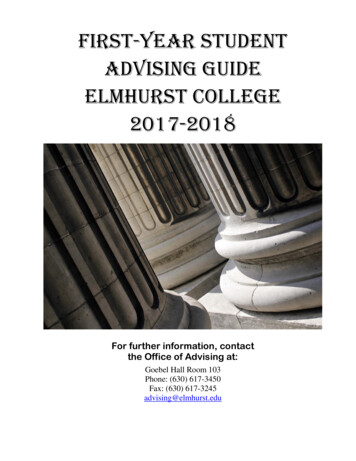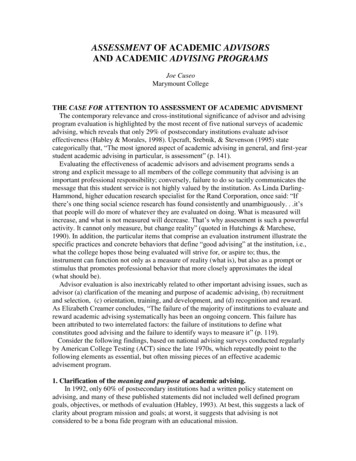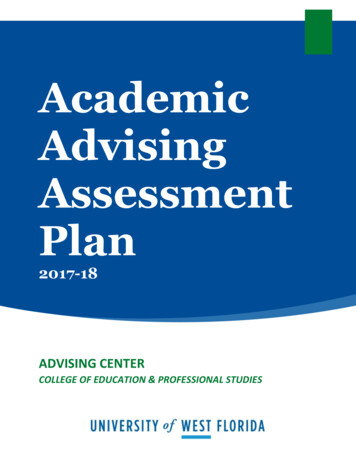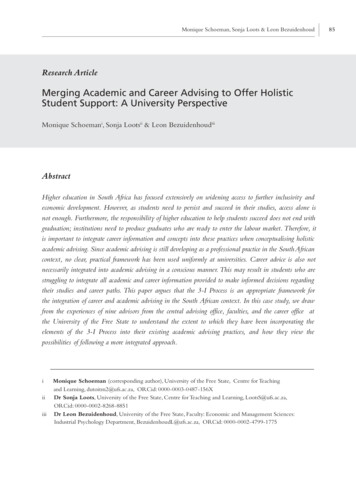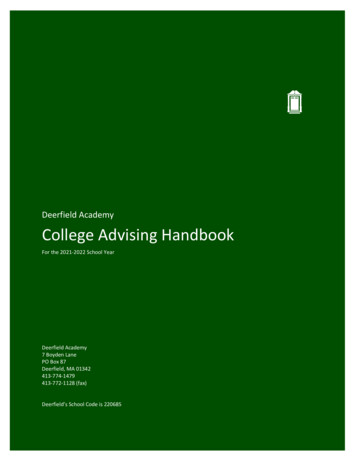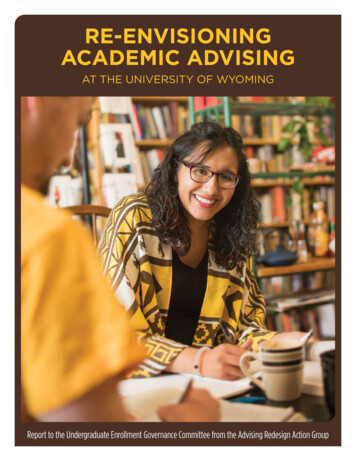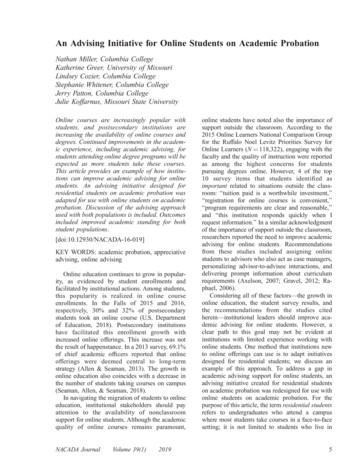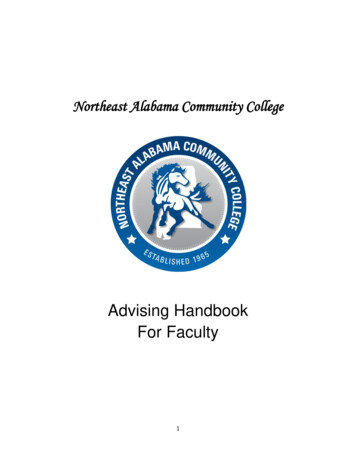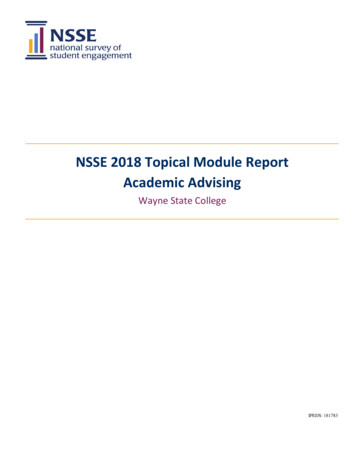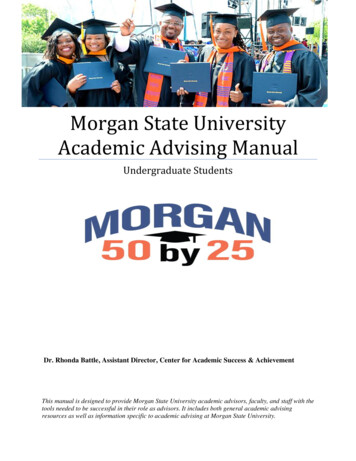
Transcription
Morgan State UniversityAcademic Advising ManualUndergraduate StudentsDr. Rhonda Battle, Assistant Director, Center for Academic Success & AchievementThis manual is designed to provide Morgan State University academic advisors, faculty, and staff with thetools needed to be successful in their role as advisors. It includes both general academic advisingresources as well as information specific to academic advising at Morgan State University.
2Table of ContentsSECTION I: OVERVIEW OF ACADEMIC ADVISING . 5Morgan State University Academic Advising Mission. 5Definition and Importance of Academic Advising . 5Academic Advising Philosophy. 6Roles and Responsibilities of the Advisor and Advisee. 6Advisor’s Role and Responsibilities . 6Advisee’s Role and Responsibilities . 7Student Benefits. 8SECTION II: ACADEMIC ADVISING STRUCTURE . 9Organizational Advising Model at Morgan State University. 9First Time Freshman Transition Criteria. 9Academic Advisor Assignment . 9First Time Freshman Advisor Assignment . 9Faculty Advisor Assignment . 10SECTION III: FOUNDATIONS OF ADVISING . 11Types of Advising . 11Prescriptive Advising . 11Developmental Advising. 11Proactive Advising . 13Appreciative Advising . 13Strengths-Based Advising. 13Strengths at Morgan State University . 14Positive Approaches to Advising . 14Ten Characteristics of a Good Advisor . 15The Do’s of Academic Advising . 15The Don’ts of Academic Advising. 17Helping Students Evaluate Alternatives and Make Decisions . 21Academic Advisor Development . 22SECTION IV: ADVISING SPECIFIC STUDENT GROUPS . 24Freshman Year . 24Sophomore Year . 24
3Junior Year . 25Senior Year . 25Honors Students . 25International Students . 26Student-Athletes . 27Students with Disabilities. 28Undeclared/Undecided Students . 28SECTION V: ACADEMIC ADVISOR FUNDAMENTALS . 29Academic Advising File and Notes . 29Academic Advisor Hold and Alternate Pin . 30Academic Advisor Hold . 30Alternate Pin . 34Academic Advising Meeting Schedule . 34General Academic Advising Meeting Tips. 35SECTION VI: MORGAN STATE UNIVERSITY – ADVISING TOOLS MODEL . 44Brief Overview of Morgan State University Advising Tools . 45Using Morgan’s Advising Tools for Course Selection Advisement. 46Before the Advising Session . 46During the Advising Session . 56SECTION VII: ACADEMIC POLICIES . 63Statute of Limitations (seven-year rule) . 63Semester Credit Hours . 63Course Numbering . 63Student Classification. 64Grade Change Policy . 64“I” Grade Policy . 64Class Load Limits . 64Course Credit for External Courses . 65Double-Counting of Courses . 65Double Major . 65Dual Degree . 66Registration . 67
4Dropping and Withdrawing from Classes . 67Repeating Courses for Credit . 6930-Hours Rule . 69Satisfactory Academic Performance . 69Academic Probation . 70Academic Dismissal . 70Academic Recovery Program . 70Academic Appeal Process . 71Proficiency Examinations . 72Independent Study. 72Baltimore Collegetown-Baltimore Student Exchange Program (BSEP) . 73SECTION VIII: GENERAL EDUCATION PROGRAM . 74Overview . 7440-Credits General Education Requirement (REVISED)* . 76References . 81Appendix . 83
5SECTION I: OVERVIEW OF ACADEMIC ADVISINGMorgan State University Academic Advising MissionAcademic advising is a critical component of the educational experience at Morgan StateUniversity. It is an intentional, collaborative, and ongoing partnership between students and theUniversity. Through this partnership, we assist students in developing, implementing, andachieving their educational, personal, and career goals while ensuring student persistence andtimely graduation. We pride ourselves on fostering an engaging learning and mentoringrelationship which supports the mutual trust and respect of both parties.Definition and Importance of Academic AdvisingAcademic advising assists students to realize the maximum educational benefits available tothem to better understand themselves and to learn to use the resources of an academic institutionto meet their educational needs and aspirations. Arguably, academic advising is “perhaps theonly opportunity for all students to develop a personal, consistent relationship with someone inthe institution who cares about them” (Drake, 2011, p. 10).Academic advising is a multifaceted activity. There are five dimensions that are significant to theadvising process. They include exploration of personal goals, exploration of career goals, reviewof academic program, selection of courses, and scheduling of classes (O’Banion, 1972).More specifically, advising should assist students to realize the maximum educational benefitsavailable to them by: Helping students to clarify their values and goals and to better understand themselves; Helping students to understand the nature and the purpose of higher education; Providing accurate information about educational options, requirements, policies andprocedures; Planning an educational program consistent with a student’s interests and abilities; Assisting students in the continual monitoring and evaluation of their educationalprogress; Integrating the resources of the institution to meet the student’s special educational needsand aspirations.
6Academic Advising PhilosophySuccessful advising is an ongoing ever present activity where students develop a personalrelationship with an advisor and develop into individuals who take responsibility for their ownlifelong learning. Its goal is long-term, and it is not confined to the selection of courses for thenext semester.Academic advising has two major components. The first is technical knowledge concerningUniversity requirements and procedures. The second is career and life planning on an ongoing,individual nature.Academic Advising includes the following: Assisting students with course registration; Listening to student concerns and questions; Providing a framework for planning career & educational goals; Proactive problem solving; Referral to campus resources/services and academic regulations & policies; Guiding the planning of a path of study and degree requirements; Ongoing monitoring of student's progress.Roles and Responsibilities of the Advisor and AdviseeAdvisor’s Role and ResponsibilitiesThe primary responsibility as an academic advisor is to guide students in making wise selectionsof course offerings with careful attention to the University’s policies and degree requirements. Inaddition, an effective advisor should also assist students in identifying available internal andexternal resources that will have a positive impact on their Morgan experience.One of the factors frequently mentioned by students as being important to them in the advisingprocess is whether or not an advisor shows concern for them as individuals. Students who feelthat their advisor cares for them as persons are more likely to value their advisor's advice, and aremore likely to return to their advisors when they are experiencing difficulties. Mutual respectbetween advisor and advisee is a goal of effective advisement programs and it is incumbent uponthe advisor to promote this rapport.
7Advisors can develop the relationship with their advisees by making the initial contact with newadvisees, e.g. write a letter of introduction - inform advisees of office hours/location, andencourage advisees to stop by for a get acquainted meeting, etc.; becoming familiar with thestudent's personal, educational, and career goals; having some knowledge of the student'sacademic ability and background; and asking about the student's progress and determiningwhether or not he/she needs assistance.In essence, the academic advisor is in a key position to: (1) structure the conditions in whichinstruction takes place; (2) facilitate student learning; (3) weave together the strands of personaland intellectual learning; and (4) help students move toward identification and fulfillment ofcareer and life goals.It is the responsibility of the academic advisor to: Be available to advisees through appointments or walk-ins – in person, via email, and/orvia phone or other established means of communication; Afford advisees ample opportunities to meet for discussion of their educationalexperiences; Provide accurate information about program requirements, MSU policies, and resourcesetc.; Acquaint advisees with general and departmental requirements, college regulations,services and opportunities; Help advisees understand the relationship of past educational achievements to theirpresent and future educational goals; Ensure students are knowledgeable about advisor/advisee responsibilities; Maintain confidentiality of students’ records when applicable; Assist students in selecting courses based on intended major and/or academic interest; Maintain accurate documentation of all advising sessions.Advisee’s Role and ResponsibilitiesIt is important to emphasize that the responsibility to meet requirements for graduation at theintended graduation date, both with respect to selecting courses and to completing themsatisfactorily, ultimately rests with the student. Ideally, a student should meet at least two times asemester with his/her academic advisor.
8Students have an important responsibility in the advising process and are encouraged to take theinitiative to seek advisement and to develop a close relationship with their advisors. Mutualrespect between advisor and advisee is a goal of effective advisement. Students share theresponsibility of establishing a productive and respectful relationship with their advisors.It is the responsibility of the advisee to: Take responsibility for educational experience; Learn how to access and use University email, WebSIS, Blackboard, Starfish, Degree Worksand any other online student success platforms; Read MSU emails on a regular basis; Become familiar with and use campus resources; Maintain contact with assigned advisor throughout the semester; Attend each advising appointment prepared to ask questions and discuss concerns; Use the Undergraduate Catalog and other resources to become knowledgeable ofacademic requirements, policies, and procedures; Know important dates and deadlines (registration, drop/add, final exams, etc.) as listed on theUniversity’s Academic Calendar; Discuss course options and selection with advisor.Student BenefitsBenefits students derive from effective academic advising and a positive advisor/adviseerelationship include: Successful attainment of their educational/career objectives; Achievement of GPAs consistent with their ability; Higher retention rates; Satisfaction with the process and development of a positive attitude toward theinstitution; Development of a meaningful relationship with their advisors.
9SECTION II: ACADEMIC ADVISING STRUCTUREOrganizational Advising Model at Morgan State UniversityAcademic advising at MSU is conducted through a shared structure, more specifically a spiltmodel. Under this model, academic advising is facilitated by staff, usually under an academicadvising center, as well as faculty in the various academic departments. Often times, the staff isresponsible for advising a particular cohort of students or all students until a certain criteria ismet.At MSU, all first time freshmen are advised by staff under the Center for Academic Success andAchievement (CASA) and the Office of Student Success and Retention (OSSR) until specificrequirements have been met. After meeting those requirements, students transition to their majordepartments for advisement.First Time Freshman Transition CriteriaAs previously mentioned, all first time freshmen are advised by an advisor from either CASA orOSSR until specific criteria is met. The criteria is outlined below. A student transitions to his/herfaculty advisor when the student has achieved all of the following: 2.0 cumulative grade At least 24 credit hours earned Declared a majorAcademic Advisor AssignmentIt is the department’s responsibility to assign an advisor to each student. Departments(schools/college, OSSR, and CASA) should promptly assign each student to an academicadvisor. Students who do not have an assigned academic advisor are referred to the departmentchair. Requests for a change of advisor should be honored if students feel it is in their bestinterest to work with a different faculty member, retention staff, or CASA advisor. If a student'sadvisor leaves the campus, or is on sabbatical, the student should promptly be assigned a newadvisor.First Time Freshman Advisor AssignmentRegular admitted first time freshmen with declared majors are advised by retention coordinatorsunder OSSR. Students who participated in CASA Academy and have successfully gained
10admission to the University are advised by CASA’s academic advisors. In addition, CASAfadvisors also advise all exploratory/undeclared majors.Faculty Advisor AssignmentStudents who meet the criteria to transition from their freshman advisor are advised by a facultyor staff person in their academic department. Transfer students with declared majors are alsoadvised by their academic departmental representative, regardless of the students’ classification.If a transfer student does not have a declared major then that student will be advised by a CASAacademic advisor until he/she declares a major.
11SECTION III: FOUNDATIONS OF ADVISINGTypes of AdvisingPrescriptive AdvisingThe traditional relationship between the academic advisor and the student may be described asprescriptive. As implied by the term itself the relationship is obviously based on authority; theadvisor is the doctor and the student is the patient. The patient comes in with some ailment. Thedoctor makes a diagnosis, prescribes something, or gives advice. Therefore, if the studentfollows the advice, the problem will be solved and all is well! In this context the advisorpresumably "teaches" and the student "learns." It cannot be denied that many faculty see theprescriptive relationship as highly convenient and desirable. Not only does it allow the professorto profess what he knows but it also makes for a tidy relationship with the student in which theadvisor may remain relatively uninvolved, if not aloof. From the viewpoint of the advisor, theassumption underlying this relationship is that once advice is given his responsibility is largelyfulfilled; now it is up to the student to fulfill his responsibility by doing what is prescribed.(Crookston, 1994, p. 5)Developmental AdvisingDevelopmental academic advising continues to be the most fundamental and comprehensiveapproach to advising practice. It enables the academic advisors to take a holistic view of eachstudent to maximize that student’s education experiences in an effort to foster his or her currentacademic, personal, and career goals toward future success. Properly practiced, it encouragesacademic advisors to use their own skills to identify each student’s skills, abilities, andexpectations; to know the resources and opportunities available to the student; and to supportmaximum growth (development) in academic, personal, and career goals. Simply stated,developmental academic advising allows the practitioner to accept the student on a threedimensional continuum and facilitate growth in each one through the coordination of a variety ofexperiences. These efforts result in the most successful and rewarding college experiencepossible. (Grites, 2013, p. 45)
12Developmental Advising Is/Is NotPerhaps an easy way to understand the concept of developmental advising is to compareprescriptive and developmental advising techniques using this chart developed by Crookston.(Crookston, 1972, p. 13)Prescriptive AdvisingDevelopmental AdvisingAdvisor tells student what he/she needs to knowabout programs and courses.Advisor helps student learn about courses andprograms for self.Advisor knows college policies and tells studentwhat to do.Advisor tells student where to learn about policiesand helps in understanding how they apply tohim/herAdvisor informs about deadlines and follows upbehind student.Advisor informs about deadlines, then lets studentfollow up.Advisor tells student which classes to take.Advisor presents class options; student makes ownselections.Advisor keeps informed about academic progressthrough files and records.Advisor keeps informed about academic progressthrough records and talking to student aboutacademic experiences.Advisor tells student what to do in order to getadvised.Advisor and student reach agreement about natureof advising relationship.Advisor uses grades and test results to determinecourses most appropriate for student.Advisor and student use grades, test results andself-determined interests and abilities to determinemost appropriate courses.Advisor specifies alternatives and indicates bestchoice when student faces difficult decisions.Advisor assists student in identifying alternativesand weighing consequences when facing difficultdecisions.Advisor suggests what student should major in.Advisor suggests steps students can take to helpdecide on major.Advisor identifies realistic academic goals basedon grades and test results.Advisor assists student in identifying realisticacademic goals based on grades, test results andself-understanding.Advisor is concerned mainly about academic lifeof student.Advisor is concerned about personal, social andacademic life of student.Advisor provides information mainly aboutcourses and class schedules.Advisor provides information about workshops andseminars in areas such as career planning and studyskills, in addition to courses and class schedules.
13Proactive AdvisingProactive Advising as an advising strategy first appeared, as intrusive advising, in the work ofGlenn (1975), who sought to blend the practices of advising and counseling into a form ofstudent intervention that allows advisors to provide students information before they request orrealize they need it. Often service based, with advisors providing needed assistance andinstitutional information to students, it promotes relationship building similar to that generated incounseling sessions. (Varney, 2013, p. 137)Appreciative AdvisingAppreciative Advising (AA) is a framework for guiding advisors wishing to move fromproviding good service to providing great service to students (Collins, 2001). It entails theintentional and collaborative practice of asking positive, open-ended questions that help studentsoptimize their educational experiences and achieve their dreams, goals, and potentials (Bloom,Hutson, & He, 2008). AA involves a six-phase model highlighting the proactive mind-set thatempowers advisors and students to a) build trust and rapport with each other (disarm); b)uncover their strengths and assets (discover); c) be inspired by each other’s hopes and dreams(dream); d) co-construct plans to make their goals a reality (design); e) provide mutual supportand accountability throughout the process (deliver); and f) challenge each other to set higherexpectations for their educational experiences (don’t settle) (Bloom et al., 2008).(Bloom, Hutson, He, 2013, p. 83)Strengths-Based AdvisingStrengths-Based Advising represents a paradigm shift for higher education from failureprevention and a survival mentality to success promotion and a perspective of thriving. Ratherthan assessing the areas in which the student is deficient and in need of remediation, advisorsusing a strengths-based approach assess the talents and personal assets that students bring intothe college environment and work with them to develop those competencies into strengthsthrough gained knowledge and skills. Instead of focusing primarily on the problems studentsmay be experiencing, advisors help students envision future possibilities and lean to leveragetalents to address obstacles that may emerge in the future (Schreiner & Anderson, 2005). Inaddition to a goal of completing college, strengths-based advisors help students make the most ofthe college experience. (Schreiner, 2013, p. 105)
14Strengths at Morgan State UniversityAt Morgan State University, all incoming freshmen are required to complete the StrengthsFinderassessment prior to their matriculation at the institution. Regular admitted freshmen completethis assessment prior to the three day ACCESS Orientation during the summer. Students whoparticipate in CASA Academy (Morgan’s six week summer alternative admissions program)complete their StrengthsFinder assessment during the first few days of the start of the summerprogram. All freshman academic advisors also complete the StrengthsFinder assessment.The StrengthsFinder assessment is a web based survey that “measures the presence of talents in34 general areas referred to as "themes." Talents are ways in which we naturally think, feel, andbehave as unique individuals, and they serve as the foundation of strengths development”. Whilethere are 34 themes, the assessment identities a student’s top five themes. These top five themesare the student’s innate abilities that are most prevalent or dominant. Through advising, freshmanorientation, and throughout CASA Academy, advisors assist “students in exploring their keythemes and talents, linking those talents to students' personal goals and objectives, applyingthose talents to college orientation skill development in areas such as time management, studystrategies, and group dynamics, and then document and exercise approaches to application bothin and outside of the classroom” (StrengthsQuest Developing Your Strengths, n.d.).Positive Approaches to AdvisingThere are several ways for an academic advisor to positively approach their responsibilities.While some of these approaches
Morgan State University Academic Advising Mission Academic advising is a critical component of the educational experience at Morgan State University. It is an intentional, collaborative, and ongoing partnership between students and the University. Through this partnership, we assist students in developing, implementing, and
